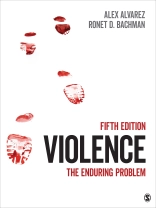The Fifth Edition of Violence: The Enduring Problem offers an interdisciplinary and reader-friendly exploration of the patterns and correlations of individual and collective violent acts using the most contemporary research, theories, and cases. Responding to concerns regarding pervasive domestic and global violence, authors Alex Alvarez and Ronet Bachman address the various legislative, social, and political efforts to curb violent behavior. They incorporate a wide range of the most current cases to help readers interpret the nature and dynamics of various forms of violence. This book stands apart from other texts with its broad perspective that includes coverage of collective acts of violence such as terrorism, mob violence, and genocide.
Содержание
Chapter 1: Defining Violence
Connecting Violence
Defining Violence
Measuring Violence
Violence and U.S. Society
Chapter 2: Why Do We Do It?
Ethological and Biological Explanations of Violence
Psychological Explanations of Violence
Sociological Explanations of Violence
Explaining Collective Violence
Chapter 3: Assault and Murder: A Continuum of Violence
Defining Assault and Homicide
Violent Interactions
What Are We Doing About Murder?
Chapter 4: Serial, Mass, and Spree Killing
Serial Murder
Spree Murder
Mass Murder
Chapter 5: Violence in the Home
Intimate Partner Violence
How Many Victims of Intimate Partner Violence Are There?
Risk Factors for Intimate Partner Violence
Violence in Lesbian/Gay/Bisexual/ Transgender/Queer (LGBTQ+) Relationships
What Are We Doing About Intimate Partner Violence?
Stalking
What Are We Doing About Stalking?
Child Abuse
What Are We Doing About Physical Child Abuse?
Elder Abuse
What Are We Doing About Elder Abuse?
Chapter 6: Rape and Sexual Assault
How Many Rape and Sexual Assault Victims Are There?
Rape on College Campuses
Rape in Prison
Rape and the U.S. Military
Genocide and Rape
Human Trafficking
Factors Related to Sexual Violence
What Are We Doing About Rape?
Chapter 7: Stranger Crime and Street Violence
Robbery
What Are We Doing About Street Robbery?
Bank Robbery
Workplace Violence
Street Gang Violence
What Are We Doing About Street Gang Violence?
Chapter 8: Hate Crimes
Violent Hate Crimes
James Byrd Jr. and Matthew Shepard: Catalysts for Modern Hate Crime Legislation
What Is a Hate Crime?
How Frequently Are Hate Crimes Carried Out?
Race-Based Hate Crime
Religion-Based Hate Crime
Hate Groups
How Can We Combat Hate Crime?
Chapter 9: Crowd Violence
Mobs and Crowds
Mob Mentality
Riots
Race Riots
Vigilantism
Chapter 10: Terrorism
Defining Terrorism
How Frequent Are Terrorist Acts?
Types of Terrorism
Who Becomes a Terrorist?
Tactics and Weapons
What Are We Doing About Terrorism?
Chapter 11: Genocide
Defining Genocide
A History of Genocide
Why Do Genocides Happen?
Precursors to Genocide
Perpetrators of Genocide
Who Are the Victims of Genocide?
When People Do Nothing: The Bystanders to Genocide
What Are We Doing About Genocide?
Chapter 12: Towards Violence Prevention
Costs of Violence
How Do We Know What Works?
Criminal Justice Responses to Violence
Violence as a Public Health Problem With a Community Response
Об авторе
Ronet D. Bachman, Ph D, worked as a statistician at the Bureau of Justice Statistics, U.S.Department of Justice, before going back to an academic career; she is now a professor in the Department of Sociology and Criminal Justice at the University of Delaware. She is coauthorof Statistical Methods for Criminology and Criminal Justice and coeditor of Explaining Criminalsand Crime: Essays in Contemporary Criminal Theory. In addition, she is the author of Death and Violence on the Reservation and coauthor of Stress, Culture, and Aggression; Murder American Style; and Violence: The Enduring Problem, along with numerous articles and papers that examinethe epidemiology and etiology of violence, with particular emphasis on women, the elderly, and minority populations as well as research examining desistance from crime. Her most recentfederally funded research was a mixed-methods study that examined the long-term desistancetrajectories of criminal justice involved drug-involved individuals who have been followed withboth quantitative and interview data for nearly thirty years. Her current state-funded research isassessing the needs of violent crime victims, especially those whose voices are rarely heard suchas loved ones of homicide victims.












